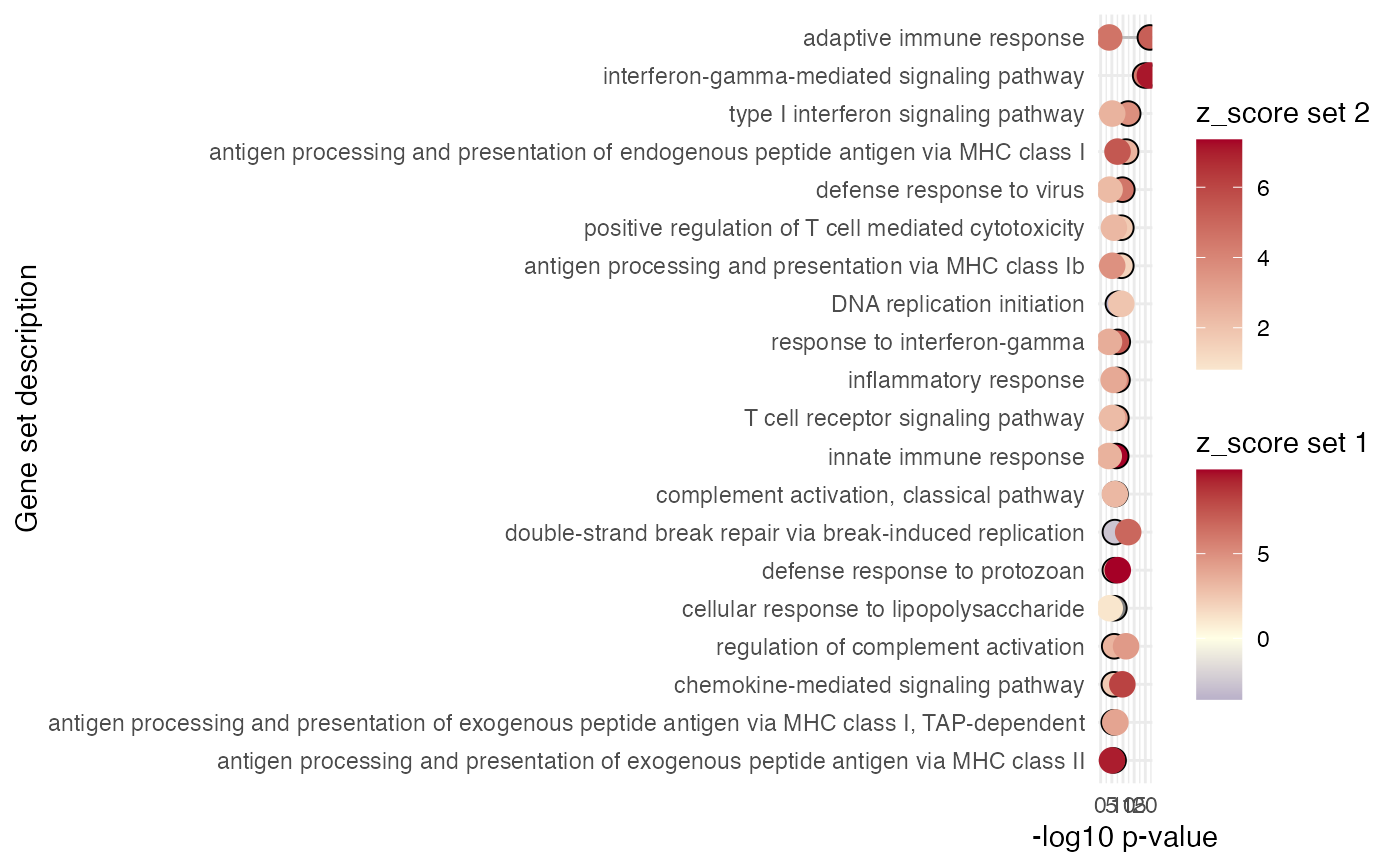Plots a summary of enrichment results - for two sets of results
gs_summary_overview_pair(
res_enrich,
res_enrich2,
n_gs = 20,
p_value_column = "gs_pvalue",
color_by = "z_score",
alpha_set2 = 1
)Arguments
- res_enrich
A
data.frameobject, storing the result of the functional enrichment analysis. See more in the main function,GeneTonic(), to check the formatting requirements (a minimal set of columns should be present).- res_enrich2
As
res_enrich, the result of functional enrichment analysis, in a scenario/contrast different than the first set.- n_gs
Integer value, corresponding to the maximal number of gene sets to be displayed
- p_value_column
Character string, specifying the column of
res_enrichwhere the p-value to be represented is specified. Defaults togs_pvalue(it could have other values, in case more than one p-value - or an adjusted p-value - have been specified).- color_by
Character, specifying the column of
res_enrichto be used for coloring the plotted gene sets. Defaults sensibly toz_score.- alpha_set2
Numeric value, between 0 and 1, which specified the alpha transparency used for plotting the points for gene set 2.
Value
A ggplot object
See also
Examples
library("macrophage")
library("DESeq2")
library("org.Hs.eg.db")
library("AnnotationDbi")
# dds object
data("gse", package = "macrophage")
dds_macrophage <- DESeqDataSet(gse, design = ~ line + condition)
#> using counts and average transcript lengths from tximeta
rownames(dds_macrophage) <- substr(rownames(dds_macrophage), 1, 15)
dds_macrophage <- estimateSizeFactors(dds_macrophage)
#> using 'avgTxLength' from assays(dds), correcting for library size
# annotation object
anno_df <- data.frame(
gene_id = rownames(dds_macrophage),
gene_name = mapIds(org.Hs.eg.db,
keys = rownames(dds_macrophage),
column = "SYMBOL",
keytype = "ENSEMBL"
),
stringsAsFactors = FALSE,
row.names = rownames(dds_macrophage)
)
#> 'select()' returned 1:many mapping between keys and columns
# res object
data(res_de_macrophage, package = "GeneTonic")
res_de <- res_macrophage_IFNg_vs_naive
# res_enrich object
data(res_enrich_macrophage, package = "GeneTonic")
res_enrich <- shake_topGOtableResult(topgoDE_macrophage_IFNg_vs_naive)
#> Found 500 gene sets in `topGOtableResult` object.
#> Converting for usage in GeneTonic...
res_enrich <- get_aggrscores(res_enrich, res_de, anno_df)
res_enrich2 <- res_enrich[1:42, ]
set.seed(42)
shuffled_ones <- sample(seq_len(42)) # to generate permuted p-values
res_enrich2$gs_pvalue <- res_enrich2$gs_pvalue[shuffled_ones]
res_enrich2$z_score <- res_enrich2$z_score[shuffled_ones]
res_enrich2$aggr_score <- res_enrich2$aggr_score[shuffled_ones]
# ideally, I would also permute the z scores and aggregated scores
gs_summary_overview_pair(
res_enrich = res_enrich,
res_enrich2 = res_enrich2
)
